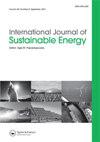绿色交通与可再生能源:对印度未来的综合分析
IF 2.7
Q4 ENERGY & FUELS
引用次数: 0
摘要
摘要 本研究探讨了印度交通和电力部门去碳化所面临的挑战,这两个部门的排放量约占全国排放量的 35%。研究引入了一个交通模型,旨在预测电动汽车在两轮车(2W)和四轮客车(4W)细分市场的增长情况,并考虑了不同的政策情景。研究评估了这些方案对技术采用、化石燃料需求、电力需求和二氧化碳排放的影响。此外,该研究还提出了一个预测全国电力需求的需求模型。还开发了电力模型,并将其与运输和需求模型联系起来,以评估不同的燃料组合方案,从而满足到 2050 年的全国电力需求预测。研究结果表明,雄心勃勃的政策方案可推动电动汽车到 2050 年占印度道路上所有 2W 和 4W 车辆的 45%,从而将电力需求大幅提高到约 295 太瓦时,并将交通部门的二氧化碳排放量减少 40%。重要的是,这些模型之间的软联系强调了印度通过风能、太阳能和水电等可再生能源满足全国 90% 电力需求的潜力。这项研究强调了通过可再生能源和电动汽车一体化向低碳能源系统过渡的可行性。本文章由计算机程序翻译,如有差异,请以英文原文为准。
Green transport and renewable power: an integrated analysis for India's future
ABSTRACT This study addresses the challenge of decarbonizing India's transportation and power sectors, which jointly contribute to around 35% of the nation's emissions. The research introduces a transport model designed to project the growth of EVs within the 2-wheeler (2W) and 4-wheeler passenger (4W) segments, considering different policy scenarios. These scenarios are assessed for their impact on technology adoption, fossil fuel demand, power requirements, and CO2 emissions. Additionally, the study presents a demand model to forecast national electricity demand. The power model is also developed and linked with the transport and demand models to evaluate different fuel mix options for meeting the projected national power demand through 2050. The findings reveal that ambitious policy scenarios can drive EVs to constitute roughly 45% of all 2W and 4W vehicles on Indian roads by 2050, substantially increasing electricity demand to an estimated 295 TWh with a 40% reduction in CO2 emissions within the transport sector. Significantly, the soft linkage between these models underscores the potential for India to meet up to 90% of its national electricity demand through renewable sources like wind, solar, and hydropower. The research underscores the feasibility of transitioning towards a low-carbon energy system through renewable energy and EV integration.
求助全文
通过发布文献求助,成功后即可免费获取论文全文。
去求助
来源期刊

International Journal of Sustainable Energy
ENERGY & FUELS-
CiteScore
5.70
自引率
3.20%
发文量
52
期刊介绍:
Engineering and sustainable development are intrinsically linked. All capital plant and every consumable product depends on an engineering input through design, manufacture and operation, if not for the product itself then for the equipment required to process and transport the raw materials and the final product. Many aspects of sustainable development depend directly on appropriate and timely actions by engineers. Engineering is an extended process of analysis, synthesis, evaluation and execution and, therefore, it is argued that engineers must be involved from the outset of any proposal to develop sustainable solutions. Engineering embraces many disciplines and truly sustainable solutions are usually inter-disciplinary in nature.
 求助内容:
求助内容: 应助结果提醒方式:
应助结果提醒方式:


